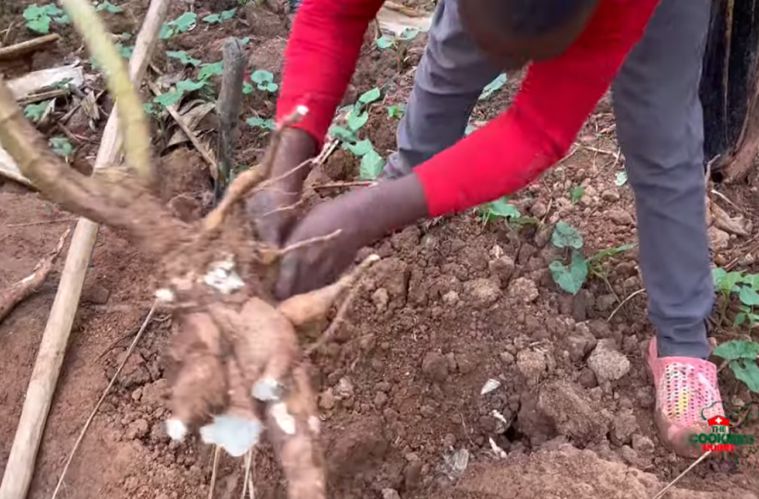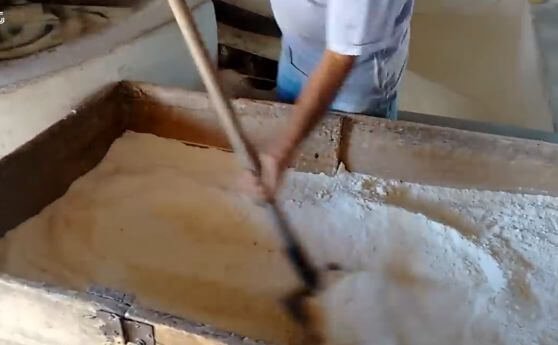The fermentation method of making cassava flour, also called fermented cassava flour enhances flavor, boosts nutrition, and removes toxins. Follow this step-by-step guide to create high-quality cassava flour effortlessly!
Making fermented cassava flour is a traditional yet highly effective technique that enhances the flour’s safety, nutrition, and flavor.
By allowing natural fermentation, this method reduces harmful cyanogenic compounds, making cassava flour safer for consumption.
It also improves digestibility and adds a distinct taste, making it a preferred choice in many cuisines.
Whether you’re a farmer, food processor, or home cook, understanding this method ensures high-quality results.
In this guide, we’ll take you through the step-by-step process of fermenting cassava for flour production, highlighting its benefits, practical applications, and essential tips for optimal results.
Recommended: The Four Methods of Making Cassava Flour

Table of Contents
- Why Use the Fermentation Method?
- Step-by-Step Process of Making Fermented Cassava Flour
- Uses of Fermented Cassava Flour
- Final Thoughts
Why Use the Fermentation Method?
Fermenting cassava before turning it into flour offers several advantages, both nutritional and functional.
This method has been traditionally used in many African, Asian, and Latin American communities to improve cassava’s edibility and utility.
1. Reduces Toxins
Cassava contains cyanogenic glycosides, natural compounds that can produce toxic cyanide when consumed in large amounts.
Improper processing can lead to cyanide poisoning, which causes severe health issues, including neurological disorders.
Fermentation helps break down these compounds, making the flour safer for consumption.
2. Enhances Flavor
Unlike raw cassava flour, which has a neutral or slightly bitter taste, fermented cassava flour develops a mildly sour flavor.
This improved flavor profile enhances the taste of traditional dishes like fufu, gari, and banku.
3. Improves Digestibility
Fermentation introduces beneficial bacteria that help break down complex carbohydrates, making the flour easier to digest.
This is particularly beneficial for individuals with sensitive digestive systems.
4. Increases Shelf Life
Microbial growth in cassava products can lead to spoilage, especially in humid environments.
Proper fermentation reduces the presence of harmful microorganisms, thereby extending the storage period of cassava flour.
Related Posts
- Modern Methods of Cassava Processing
- Traditional Method of Producing Cassava Flour
- How High-Quality Cassava Flour is Made
- Making of Cassava Flour Industrially
- Which Flour Can Substitute for Cassava Flour
Step-by-Step Process of Making Fermented Cassava Flour
1. Harvest and Select Quality Cassava Roots

The quality of the final flour product begins with the selection of the right cassava roots.
Choose mature, healthy cassava (typically 8–18 months old) to ensure high starch content and minimal fiber.
Avoid diseased, bruised, or pest-infested roots, as they can compromise the quality of the flour.
2. Peel and Wash the Cassava

Using a sharp knife, remove the thick outer peel of the cassava roots. The skin contains anti-nutritional factors, which can affect the final product’s quality.
Wash the peeled cassava thoroughly with clean water to remove dirt, sand, and other impurities.
3. Chop or Grate the Cassava
Chop the cassava into smaller chunks or grate it into a fine mash. This increases the surface area, allowing for more effective fermentation.
The size of the pieces can influence the fermentation speed, with smaller pieces fermenting faster due to better bacterial penetration.
4. Soak in Water for Fermentation

Place the chopped or grated cassava in a clean, non-reactive container filled with water. Allow it to ferment for 2 to 4 days at room temperature.
The duration of fermentation depends on environmental conditions and the desired level of acidity.
During fermentation:
- Beneficial microorganisms, such as lactic acid bacteria, proliferate and help break down cyanogenic glycosides.
- The pH level decreases, creating an environment that inhibits harmful bacteria.
- The cassava softens, making it easier to process in the next steps.
After fermentation, the cassava roots must be soft and can be mashed into pulp. Mash properly into a semi-liquid and bad into a bag that can drain the water without losing the pup.
5. Drain and Press the Cassava

Once fermentation is complete, drain the cassava to remove excess water. If using grated cassava, press it using a cloth sack, press machine, or weighted method.
Removing excess moisture is crucial to ensure faster and more efficient drying in the next step.
6. Sun-Dry or Mechanically Dry the Cassava

Drying is a critical step that prevents spoilage and enhances shelf stability. There are two primary drying methods:
- Sun-Drying: Spread the cassava mash or pressed pieces on clean drying mats or trays under direct sunlight. Stir occasionally to ensure even drying. This method is cost-effective but requires several days of consistent sunshine.
- Mechanical Drying: Industrial drying machines or ovens can be used for faster drying, ensuring uniform moisture reduction. This is ideal for large-scale production where consistent quality is required.
The cassava must be dried until it reaches a moisture content of 10-12% to prevent microbial growth.
7. Mill the Dried Cassava into Flour and Sieve

Once completely dry, grind the cassava into a fine flour using a milling machine or traditional mortar and pestle.
For uniform consistency, the flour should be sifted through a fine mesh sieve to remove any coarse particles.
8. Package and Store
Store the finished fermented cassava flour in airtight containers or sealed plastic bags to protect it from moisture, pests, and contamination.
Keeping the flour in a cool, dry place extends its shelf life. For commercial production, proper labeling and adherence to food safety standards are essential.
Uses of Fermented Cassava Flour
Fermented cassava flour is incredibly versatile and can be used in various food applications:
1. Traditional Foods
Many African, Caribbean, and South American communities use fermented cassava flour in staple dishes, including:
- Fufu: A starchy, dough-like food often served with soups and stews.
- Gari: A fermented, dried, and toasted cassava product used in making porridge or eaten with soup.
- Banku: A fermented cassava and corn dish popular in Ghana.
2. Gluten-Free Baking
Fermented cassava flour serves as an excellent substitute for wheat flour in:
- Pancakes
- Flatbreads
- Cakes
- Crackers
Its slightly sour taste adds depth to baked goods.
3. Thickening Agent
This flour acts as a natural thickener for soups, stews, and sauces, providing a smooth texture without the need for artificial additives.
4. Animal Feed
Some farmers use fermented cassava flour in animal feed formulations due to its enhanced digestibility and reduced toxin levels.
Final Thoughts
The fermentation method of making cassava flour is an effective way to enhance food safety, improve digestibility, and boost flavor.
Whether used in traditional dishes or modern gluten-free recipes, fermented cassava flour remains a valuable ingredient worldwide.
For home or commercial production, following the proper fermentation process ensures high-quality flour that meets safety and nutritional standards.
With increasing demand for gluten-free and naturally processed food products, fermented cassava flour continues to gain popularity as a healthy and sustainable option.

Chimeremeze Emeh is a writer and researcher passionate about Africa’s most transformative root crop—cassava. Through his work at cassavavaluechain.com, he explores the entire cassava industry, from cultivation and processing to its diverse applications in food, health, and industrial use.
He also writes for palmoilpalm.com, where he shares his extensive experience and deep-rooted knowledge of palm oil, covering red palm oil, palm kernel oil, and refined products. His work there reflects his lifelong connection to agriculture and his commitment to promoting sustainable value chains in Africa.
Driven by curiosity and purpose, Chimeremeze aims to shed light on how cassava continues to empower communities, strengthen food systems, and link traditional farming wisdom with modern innovation.
